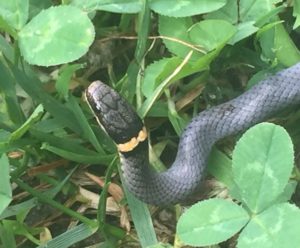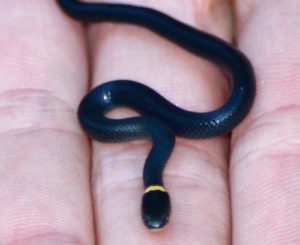Volume 23 Issue 2, Summer 2018
by Randy Bowman
 The Ringneck snake is one of the most common reptiles on the North American continent. The subspecies called the Northern Ringneck is found right here in Northern Virginia, but thanks to an astounding variability of diet and habitat, Ringnecks can also be seen all up and down the East Coast, in Mississippi, and out west in the prairies and throughout the Midwest. They can also be found in several places in and around California, with varieties including the Todos Santos Island snake and the San Bernardino snake.
The Ringneck snake is one of the most common reptiles on the North American continent. The subspecies called the Northern Ringneck is found right here in Northern Virginia, but thanks to an astounding variability of diet and habitat, Ringnecks can also be seen all up and down the East Coast, in Mississippi, and out west in the prairies and throughout the Midwest. They can also be found in several places in and around California, with varieties including the Todos Santos Island snake and the San Bernardino snake.
Ringneck snakes are very diverse in the number of variations they have. The Ringneck is one species (Diadophis punctatus) with about 14 different subspecies that are spread out across North America. These include the Southern Ringneck, which is also found in parts of Virginia. Thirteen of the subspecies measure up to about 10 to 15 inches as an adult, with juveniles averaging around six to eight inches. The one exception is the Regal Ringneck (D. p. regalis), which can reach up to 18 inches. Their relatively small size has led to their having a very specialized role in their ecosystems.

Photos by Sharon Plummer
The Ringneck’s life begins sometime in June or July as an egg laid either in a solitary nest (with its own mother guarding it) or a communal nest with lots of mothers (such nests are not uncommon). The eggs, which are about 2 centimeters long, hatch in either August or September. The moment these tiny 10-centimeter-long babies make it out of the nest, they are on their own. No adult will care for them; it’s them versus everything for the rest of their lives.
It takes four years for a Ringneck to become sexually mature, after which it will mate once a year, either in the spring or fall, depending on when it hatched. During mating season, Ringnecks live in large groups and sustain a communal lifestyle. But once mating season ends, it’s back to the old “them versus everything” routine, which leads to a high mortality rate among young snakes. A very lucky Ringneck will live for 20 years before dying of old age.
Ringnecks are relatively soft-scaled: their scales are skin-like and not good at retaining moisture. This forces them to live in damp or moist environments. While it would be easier to say that these snakes enjoy living in the woods, wetlands or forests, Ringnecks seem to be very picky about where they are in these biomes, often choosing spaces under logs, dense clumps of leaves, near stream banks, and holes in the ground that they have dug for themselves. They will live pretty much anywhere that fits their terms and conditions, which seem to consist of three requirements: shaded, damp and small. Virginia residents often discover them in leaf piles.
Rather than eating insects, Ringnecks mostly prey on species smaller than mice, including salamanders and newts, slugs, earthworms, some frogs and toads, and baby snakes. In so doing, the Ringneck provides a huge service to the ecosystem. Salamanders, newts, toads and frogs are all insect-eating animals, and by preying upon those species, the Ringneck helps brings balance to the insect population. Ringnecks also eat slugs and earthworms, both of which are fungi and leaf eaters. Thus the Ringneck is helping to balance the fungi and plant populations, which also has a large impact on the ecosystem.
While Ringneck snakes play an important role in the ecosystem as predators, many other animals see them as prey. Ringnecks are relatively small when young, so not many animals are interested in eating them, but several species fancy them either as a snack or a full meal. Juvenile Ringnecks are preyed upon by animals that can just about fit in your hand, including small carnivorous birds (like Kingfishers), large toads, larger snakes, small mammals (rats are important predators), and even large spiders and centipedes. Adult Ringnecks have even more to fear from a much larger group of predators, including small birds of prey (such as the Red-tailed Hawk), larger snakes (the Black Rat Snake is one), opossums, ferret-like animals such as shrews and ferrets, skunks, raccoons, bullfrogs and even occasionally the armadillo.
Ringneck snakes have managed to spread across an entire continent despite overwhelming odds and a staggering number of predators. Over thousands of years of migration and adaptation, these snakes have evolved into several somewhat different subspecies. These little reptiles have managed to do all that while facing multiple environmental challenges along the way. If that’s not impressive, I don’t know what is!
Randy is a high school student with a passionate interest in our natural environment and all its inhabitants

